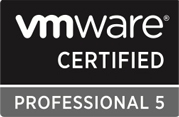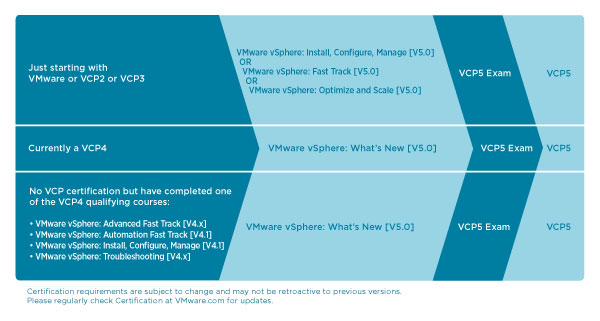Summary & Schedule
VMware VSphere: Fast Track V5.5 Course Information
Course Length: 5 Days
This intensive, extended-hours training course focuses on installing, configuring, and managing VMware vSphere® 5.5. This course combines the content of the VMware vSphere: Install, Configure, Manage course with advanced tasks and skills for configuring a highly available and scalable virtual infrastructure. The course is based on VMware ESXi™ 5.5 and VMware® vCenter Server™ 5.5. Completion of this course satisfies the prerequisite for taking the VMware Certified Professional 5 exam.
Course Objectives
At the end of the course, you should be able to do the following:
- Configure and manage ESXi networking and storage
- Create, configure, migrate, manage, and monitor virtual machines and virtual appliances
- Manage user access to the VMware virtual infrastructure
- Use vCenter Server to monitor resource usage
- Implement VMware vSphere® High Availability and vSphere® Fault Tolerance (FT)
- Use host profiles to manage ESXi configuration compliance
- Use vSphere distributed switches to scale networking
- Use prolicy-driven storage and VMware vSphere® Storage DRS™ to scale storage
- Use VMware vSphere® Update Manager™ to apply ESXi patches
- Use VMware vSphere® Management Assistant (vMA) to manage vSphere
- Deploy ESXi, vCenter Server, and VMware® vCenter Server™ Appliance™
- Use VMware vSphere® ESXi™ Image Builder CLI to create an ESXi image
- Use VMware vSphere® Auto Deploy to provision ESXi hosts
Pre-requisites
- System administration experience on Microsoft Windows or Linux operating system
- Understanding of concepts presented in the VMware Data Center Virtualization Fundamentals course for VCA-DCV certification
Intended Audience
- Solution architects
- System Engineers
- Network Engineers
- Network Administrators
- vSphere Administrators
- Storage Administrators
- System administrators
- VCP Candidates
Outline
Sample VMware vSphere: Fast Track V5.5 Course Outline
Lesson 1: Course Introduction
- Introductions and course logistics
- Course objectives
Lesson 2: Software-Defined Data Center
- Introduce virtualization and vSphere components
- Explain the concepts of server, network, and storage virtualization
- Describe where vSphere fits into the cloud architecture
- Install and use vSphere user interfaces
- Describe the ESXi architecture and configure various ESXi settings
Lesson 3: Creating Virtual Machines
- Introduce virtual machines, virtual machine hardware, and virtual machine files
- Deploy a single virtual machine
Lesson 4: VMware vCenter Server
- Introduce vCenter Server architecture
- Introduce vCenter Server Appliance
- Install and configure vCenter Server Appliance
- Using the VMware vSphere® Web Client
- Configuring VMware® vCenter™ Single Sign-On™
- Manage vCenter Server inventory objects and licenses
Lesson 5: Configuring and Managing Virtual Networks
- Describe, create, and manage a standard switch
- Describe and modify standard switch properties
- Describe the NIC teaming of a standard switch port group
Lesson 6: Configuring and Managing Virtual Storage
- Introduce storage protocols and device names
- Configure ESXi with iSCSI, NFS, and Fibre Channel storage
- Create and manage VMware vSphere® VMFS datastores
- Introduce VMware® Virtual SAN™ datastores
Lesson 7: Virtual Machine Management
- Use templates and cloning to deploy virtual machines
- Modify and manage virtual machines
- Create and manage virtual machine snapshots
- Perform VMware vSphere® vMotion® and VMware vSphere® Storage vMotion® migrations
- Create a VMware vSphere® vApp™
Lesson 8: Access and Authentication Control
- Control user access through roles and permissions
- Discuss ESXi host access and authentication
- Integrate ESXi with Active Directory
Lesson 9: Resource Management and Monitoring
- Introduce virtual CPU and memory concepts
- Describe methods for optimizing CPU and memory usage
- Configure and manage resource pools
- Use vCenter Server performance graphs and alarms to monitor resource usage
Lesson 10: High Availability and Fault Tolerance
- Explain the vSphere HA architecture
- Configure and manage a vSphere HA cluster
- Set vSphere HA advanced parameters
- Enable vSphere FT on a virtual machine
- Describe VMware vSphere® Replication
Lesson 11: Network Scalability
- Create, configure, and manage vSphere distributed switches, network connections, and port groups
- Discuss distributed switch features, such as private VLANs, discovery protocols, VMware vSphere® Network I/O Control, NetFlow, and port mirroring
Lesson 12: Host Scalability
- Use host profiles to manage ESXi configuration compliance
- Configure and manage a VMware vSphere® Distributed Resource Scheduler™ cluster
- Configure Enhanced vMotion Compatibility
- Use vSphere HA and vSphere DRS together
Lesson 13: Storage Scalability
- Describe VMware vSphere® Storage APIs – Array Integration and Storage Awareness
- Explain policy-driven storage
- Add a storage policy to a virtual machine storage profile
- Introduce VMware vSphere® Storage I/O Control
- Create a datastore cluster
- Configure Storage DRS
Lesson 14: Patch Management
- Use vSphere Update Manager to manage ESXi patching
- Install vSphere Update Manager and the vSphere Update Manager plug-in
- Create patch baselines
- Scan and remediate hosts
Lesson 15: VMware Management Resources
- Describe vSphere Management Assistant
- Configure vSphere Management Assistant
- Discuss the VMware vSphere® Command-Line Interface command set
- Perform command-line operations for host management, network management, storage management, and performance monitoring
Lesson 16: Installing VMware Components
- Describe vCenter Linked Mode to manage multiple vCenter Server inventories
- Introduce ESXi installation
- Describe boot-from-SAN requirements
- Describe vCenter Server hardware, software, and database requirements
- Install vCenter Server (Windows-based)
Lesson 17: Host and Management Scalability
- Configure and manage VMware vSphere® Distributed Power Management™
- Use VMware vSphere® PowerCLI™
- Use vSphere ESXi Image Builder CLIto create an ESXi installation image
- Use vSphere Auto Deploy to deploy a stateless ESXi host
Certification
VMware vSphere: Fast Track V5.5 Certification Information
VMware Certified Professional – Datacenter Virtualization

As the demand for IT professionals with datacenter virtualization skills increases, it is essential to distinguish yourself in the market with a certification that validates your technical capabilities. Becoming a VMware Certified Professional does just that.
This industry-recognized certification requires completion of a VMware-authorized training course and hands-on experience with VMware technologies. Achieving the VCP certification confirms that you have the education needed to successfully install, deploy, scale and manage VMware vSphere environments, as well as the skills obtained by a minimum of six months experience with VMware infrastructure technologies.
VMware Certified Professional – Datacenter Virtualization (on vSphere 5)
Become a VCP5-DV
There are different paths to VCP5-DV certification based on your background. Choose your path and complete the three core validation components:
- Attend a qualifying VMware authorized course.
- Gain hands-on experience with VMware vSphere 5.
- Pass the VCP5-DV Exam.

Certification Price
The cost of the VMware Certified Professional – Datacenter Virtualization certification is $175.00. Testing is available at authorized VMTraining testing centers throughout the world. Click here to purchase a certification exam voucher.
